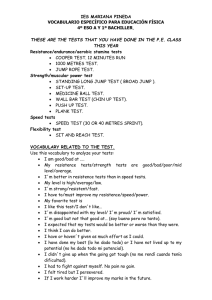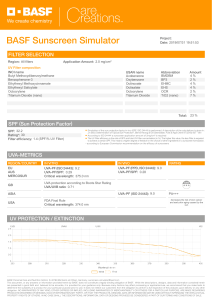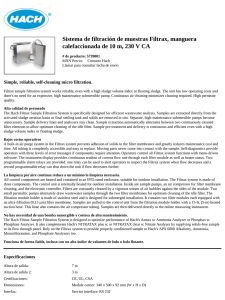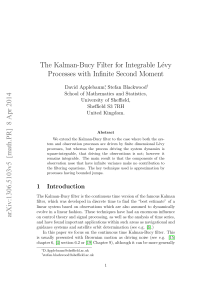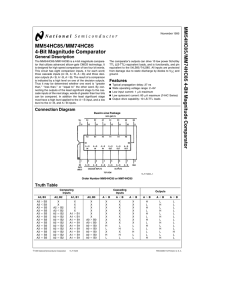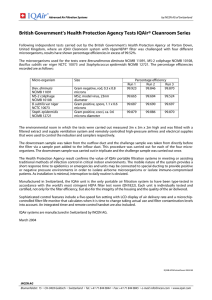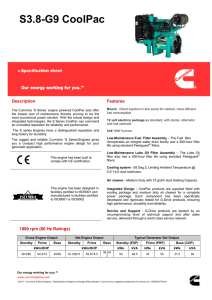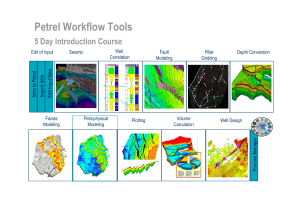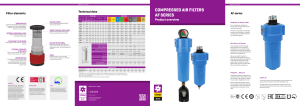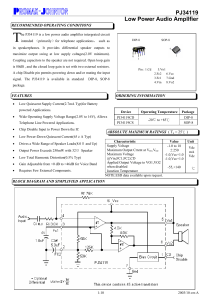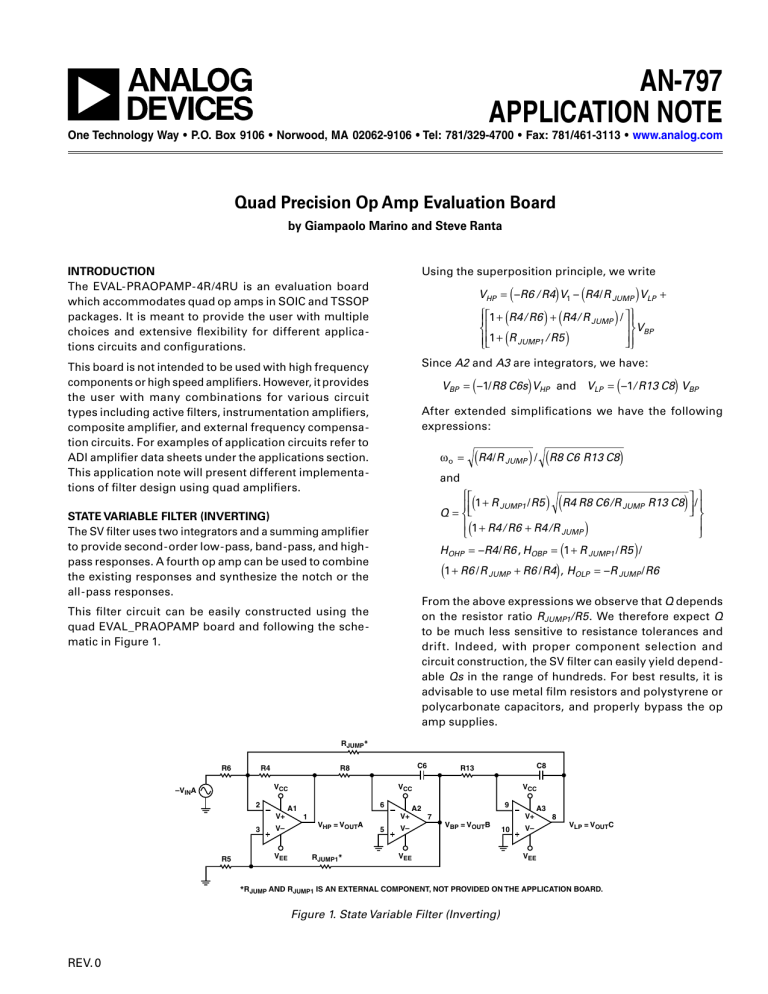
AN-797 APPLICATION NOTE One Technology Way • P.O. Box 9106 • Norwood, MA 02062-9106 • Tel: 781/329-4700 • Fax: 781/461-3113 • www.analog.com Quad Precision Op Amp Evaluation Board by Giampaolo Marino and Steve Ranta INTRODUCTION The EVAL-PRAOPAMP- 4R/4RU is an evaluation board which accommodates quad op amps in SOIC and TSSOP packages. It is meant to provide the user with multiple choices and extensive flexibility for different applications circuits and configurations. Using the superposition principle, we write This board is not intended to be used with high frequency components or high speed amplifiers. However, it provides the user with many combinations for various circuit types including active filters, instrumentation amplifiers, composite amplifier, and external frequency compensation circuits. For examples of application circuits refer to ADI amplifier data sheets under the applications section. This application note will present different implementations of filter design using quad amplifiers. Since A2 and A3 are integrators, we have: VHP = ( –R6 / R4) V1 – (R4 / R JUMP ) VLP + 1 + (R4 / R6 ) + (R4 / R JUMP ) / VBP 1 + (R JUMP1 / R5 ) VBP = ( –1/ R8 C6s) VHP and VLP = ( –1/ R13 C8) VBP After extended simplifications we have the following expressions: ωo = (R4 / R JUMP ) / (R8 C6 R13 C8) and ( ) / (1 + R JUMP1 / R5 ) R4 R8 C6 /R JUMP R13 C8 Q = (1 + R4 / R6 + R4 /R JUMP ) HOHP = –R4 / R6 , HOBP = (1 + R JUMP1 / R5 ) / STATE VARIABLE FILTER (INVERTING) The SV filter uses two integrators and a summing amplifier to provide second-order low-pass, band-pass, and highpass responses. A fourth op amp can be used to combine the existing responses and synthesize the notch or the all-pass responses. (1 + R6 / R JUMP + R6 / R4) , HOLP = –R JUMP / R6 From the above expressions we observe that Q depends on the resistor ratio RJUMP1/R5. We therefore expect Q to be much less sensitive to resistance tolerances and drift. Indeed, with proper component selection and circuit construction, the SV filter can easily yield dependable Qs in the range of hundreds. For best results, it is advisable to use metal film resistors and polystyrene or polycarbonate capacitors, and properly bypass the op amp supplies. This filter circuit can be easily constructed using the quad EVAL_PRAOPAMP board and following the schematic in Figure 1. RJUMP* R6 R4 C6 R8 VCC –VINA 2 V+ 3 R5 V– VEE C8 R13 VCC A1 6 1 VHP = VOUTA RJUMP1* V+ 5 A2 V– VCC 9 7 VBP = VOUTB VEE V+ 10 A3 V– 8 VLP = VOUTC VEE *RJUMP AND RJUMP1 IS AN EXTERNAL COMPONENT, NOT PROVIDED ON THE APPLICATION BOARD. Figure 1. State Variable Filter (Inverting) REV. 0 AN-797 The SV filter is usually implemented with R4 = R6 = RJUMP, R8 = R13 = R and C6 = C8 = C. So, the above expressions simplify to ω o = 1/ RC THE BIQUAD FILTER This particular filter implementation consists of two integrators. The third op amp is a unity gain inverting amplifier whose sole purpose is to provide polarity reversal. Q = 1/ 3 (1 + R JUMP1 / R5 ) HOHP = –1 HOBP = Q Unlike the SV filter, the biquad yields only two significant responses; however, since all its op amps are operated in the inverting mode, the circuit is immune from commonmode limitations. HOLP = –1 The filter is tuned as follows: 1. Adjust R6 for desired magnitude of the response of interest. 2. Adjust R8 or R13 to tune o. 3. Adjust the ratio RJUMP1/R5 to tune Q. From the circuit above we have: HOBP = –R4 / R6 ω o = 1/ STATE VARIABLE FILTER (NONINVERTING) Another popular type of state variable filter can be formed by just moving the input signal from the inverting to the noninverting side of A1, resulting in the noninverting state variable filter. See Figure 2. (R8 R JUMP C6 C4) HOBP = –R4 / R6 ω o = 1/ RC (R8 R JUMP C6 ) HOLP = R / R6 Q = R4 / R This filter is tuned as follows: 1. Adjust R8 or RJUMP to tune o. 2. Adjust R4 to tune Q. 3. Adjust R6 for desired values HOBP or of HOLP. R4 = R6; R8 = R13 ; R5 = RJUMP ; C6 = C8 It can be shown that: HOHP = 1/ Q Q = R4 C4 / The biquad filter is usually implemented with R8 = RJUMP = R C4 = C6 = C, after which the above expressions simplify as: By properly choosing the following components: ω o = 1/ R8 C6 HOLP = R JUMP / R6 Q = 1 + R JUMP1 / R3 HOBP = –1 HOLP = 1/ Q R6 R4 JUMP –VINA TO VOUTC C6 R8 VCC 2 A1 V+ 6 1 VEE R5 +VINA VCC V– 3 C8 R13 VHP = VOUTA V+ 5 VCC A2 9 7 V– VBP = VOUTB V+ 10 VEE RJUMP* A3 8 V– VLP = VOUTC VEE R3 *RJUMP IS AN EXTERNAL COMPONENT, NOT PROVIDED ON THE APPLICATION BOARD. Figure 2. State Variable Filter (Noninverting) RJUMP* R4 C4 C6 R8 VCC R6 2 V+ –VINA 3 A1 V– VEE R13 R16 VCC 6 1 VHP = VOUTA V+ 5 A2 V– VCC 9 7 VBP = VOUTB VEE V+ 10 A3 8 V– VLP = VOUTC VEE *RJUMP IS AN EXTERNAL COMPONENT, NOT PROVIDED ON THE APPLICATION BOARD. Figure 3. Biquad Filter –2– REV. 0 AN-797 C4 R4 VCC R6 –IN A R1* C1 G1 RT1 2 G1 R7* 1 R5* +IN A 3 C2 RT2 G2 G2 R3 C3 VOUTA RL1 R2* VEE 0 C6 R11 R8 –IN B RT3 6 G3 7 R9* +IN B R12* 5 VOUTB RL2 RT4 G4 R10 C5 0 C8 R16 R13 –IN C RT5 9 G5 8 R14* +IN C R17* 10 VOUTC RL3 RT6 G6 R15 C7 0 C10 R21 R18 –IN D RT7 13 G7 14 R19* +IN D 12 R22* VOUTD RL4 RT8 G8 R20 C9 0 Figure 4. Quad Precision Op Amp Evaluation Board Electrical Schematic REV. 0 –3– AN05566–0–12/05(0) AN-797 Figure 5. Quad Precision Op Amp Evaluation Board Layout Patterns © 2005 Analog Devices, Inc. All rights reserved. Trademarks and registered trademarks are the property of their respective owners. –4– REV. 0
